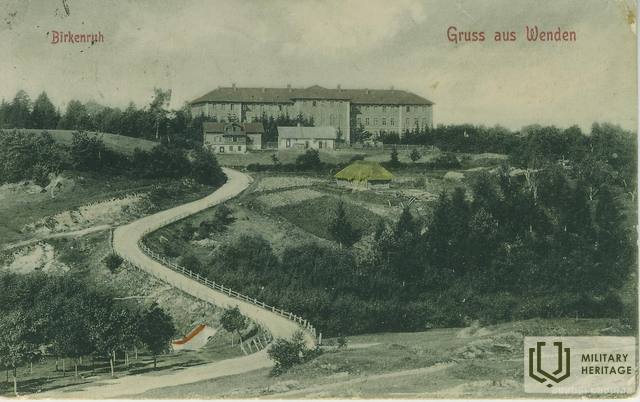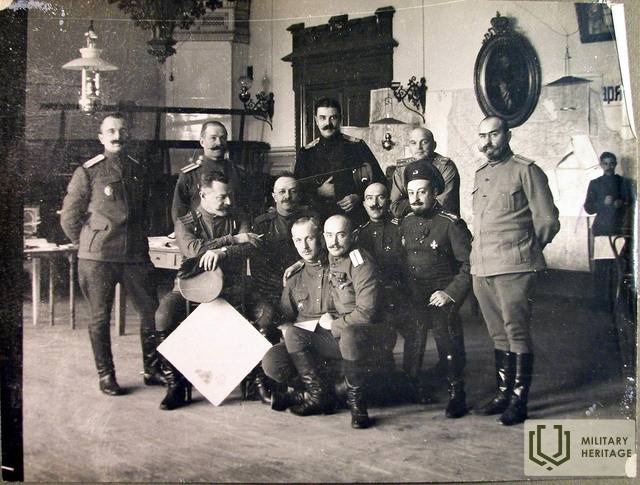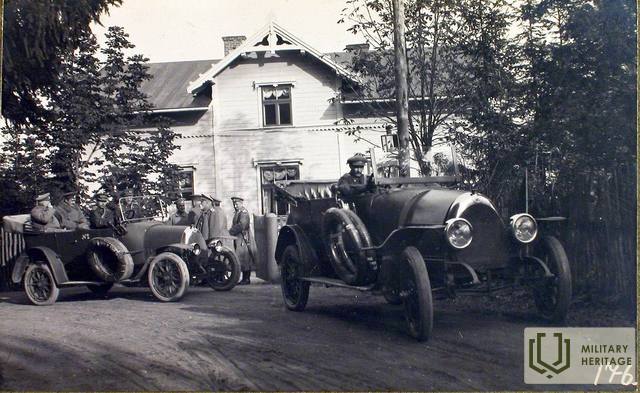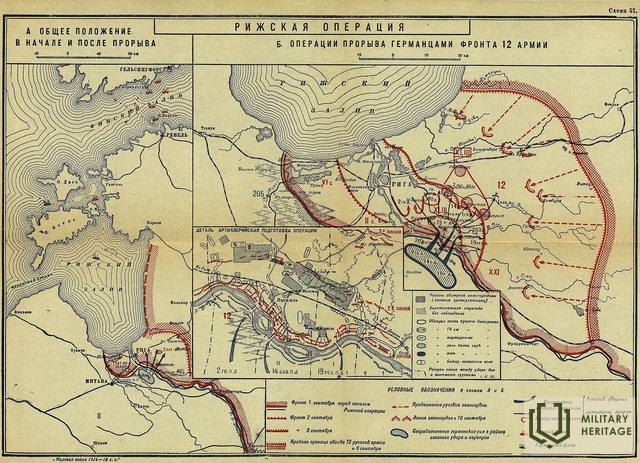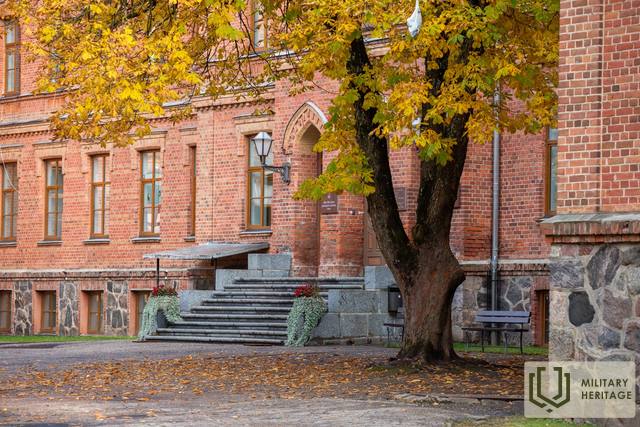Bērzaine Gymnasium - Witness of the First World War
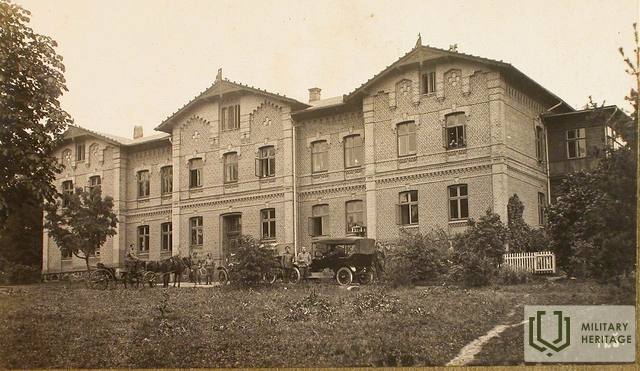
In the spring and summer of 1915, German troops occupied Courland and Semigallia. The troops of the warring parties were stationed on the banks of the Daugava River. Vidzeme became a frontline territory, and Cēsis a frontline city, around which the headquarters of the 12th Army of the Northern Front of the Tsarist Russian Army was located, which in the summer and autumn of 1915 moved to Bērzaine near Cēsis (Birkenruh bei Wenden), in the building and territory of the current Cēsis Bērzaine Elementary School.
The 12th Army Headquarters was formed in January 1915. On 13 August 1915, after the division of the Northwestern Front into the Northern and Western Fronts, the 12th Army Headquarters was disbanded, and the 13th Army Headquarters was renamed the 12th Army Headquarters. It was stationed in Kovel, Volhynia Governorate, but in the summer and autumn of 1915 it moved to Birkenruh bei Wenden.
At the end of 1915, the Germans began to build defensive positions on the outskirts of Riga. This front remained unchanged until August 1917. For almost two years, Latvian riflemen fought on the Riga Front as part of the 12th Army in the territory of Latvia.
The 12th Army (commander Dmitry Parsky — Дмитрий Павлович Парский) on the Riga Front before the German attack in August 1917 had 192,000 soldiers, 1,102 cannons and 1,900 machine guns, including 18,500 soldiers and 102 machine guns in eight Latvian rifle regiments. The army's operational combat headquarters was located near the front, but the headquarters that planned the army's recruitment, supply and construction of fortified defensive lines was located in Bērzaine near Cēsis. For the needs of the case of a retreat, the Cēsis (Vendena) fortification line or Cēsis (Vendena) positions was built, which stretched in a semicircle from the Daugava near Koknese through Mālpīles to the mouth of the Pēterupe into the Gulf of Riga. Map: Zusammendruck Riga
In Cēsis, the headquarters of the 12th Army used not only the main building of the Bērzaine Gymnasium for the work and living needs of its personnel, but also other residential and utility buildings of the teachers of this educational institution, as well as private houses in the vicinity of the school. The Peace Court House in the city was also adapted for the needs of the headquarters court. In September 1917, when the Russian troops withdrew from the Riga front, the premises of Bērzaine were also destroyed. For some time, horses were even kept on the 1st and 2nd floors of the school.
Units of the 12th Army participated in the Riga Operation, also known in military history as the Battle of Riga or Ittier's Riga Offensive. It was an offensive operation of the 8th Army of the German Empire during World War I with the aim of capturing Riga. The battle took place from 1 to 6 September 1917. More than 60,000 soldiers participated in the attack on the German side, while 161,000 soldiers defended themselves on the Russian side. The combat-capable units of the 12th Army were unable to delay the Germans. The units remaining in Riga retreated with the army to Vidzeme.
After World War I, from 1920, the building housed the Cēsis (Bērzaine) State Secondary School.
Now in these premises is the Cēsis Bērzaine Elementary School - Development Center.
History of Bērzaine Gymnasium
In May 1825, Alberts Voldemārs Holanders, born into a patrician family in Riga, founded his educational institution in Brenguļi (Alt-Wrangelshof) near Valmiera. He had studied theology and pedagogy in Tērbat, Jena, and Berlin. In October 1826, Holanders moved his educational institution to Bērzaini near Cēsis (Birkenruh bei Wenden), and established a prestigious school there, the fame of which far exceeded the borders of Vidzeme province.
In 1880, the Vidzeme Knights' Landtag decided to buy Bērzainis and establish a knights' gymnasium there. The construction of the new building began, which was paid for by the government. The State Council, following the proposal of the Minister of Public Enlightenment, allowed the Vidzeme nobility to open an educational institution in Bērzainis near Cēsis in 1882 under the name "Emperor Alexander II Gymnasium". In August 1882, a classical gymnasium with German as the language of instruction was opened on the basis of the school founded by A. Holanders.
In 1889, the State Council, following the proposal of the Ministry of Public Enlightenment, decided to close the "Emperor Alexander II Gymnasium" in Bērzaine within three years. The closing ceremony of the Bērzaine Gymnasium took place on June 6, 1892.
Since the establishment of the educational institution founded by A. Hollander, the following have served as its directors: from 1825 to 1861 - Dr. Albert Hollander (Hollander); 1861-1869 - Martin Leffler (1813-1869; Löffler) 1861–1869; 1869-1882 - Albert Leffler (1843-1899; Löffler); 1882-1884 - Prof. Dr. Ernest Koch (1839-1920; Koch); 1885 –1885 - Herman Stief (1853-1888; Stief) acting; 1886–1892 - Adolf Felt (1841-1925; Feldt).
With the permission of the Ministry of Public Enlightenment, the Vidzeme Knights' Gymnasium for Men resumed its work in Bērzaine near Cēsis in 1906, but it ceased its activities during the First World War. From 1906 to 1913, he worked as the director of the gymnasium.
Reinhold Tantscher (born 1863; Tantscher), but from 1914 to 1915 the duties of director were performed by Leo Goertz (born 1856; Goertz).
Tālis Pumpuriņš, Cēsis History and Art Museum
https://gwar.mil.ru/?year=1917&month=9&event=771
https://lv.wikipedia.org/wiki/R%C4%ABgas_oper%C4%81cija#cite_ref-autogenerated1_1-0




